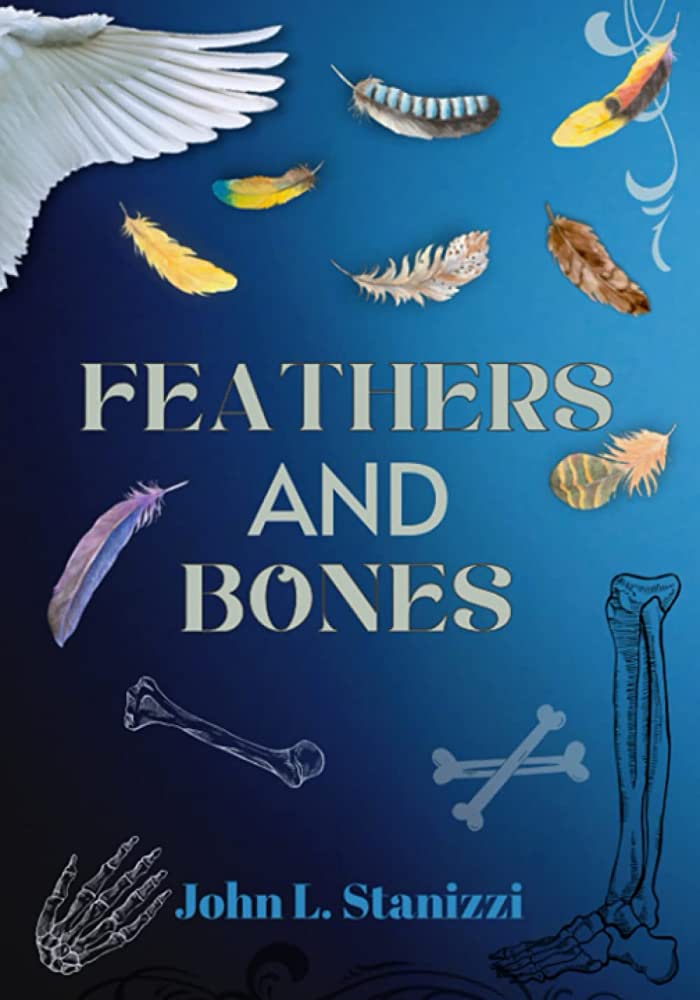The raw beauty of Stanizzi’s words are the result of
his innate ability to keep both head and heart in
balance, creating poems that buzz and thrum in the
body as well as the mind. Winged silver, bones,
dreaming, barbed wire, ghosts, Jah, harmony in all
of its manifestations as well as unspeakable loss and
other deeply felt human experiences, show us a life experiences, which include being both compassionate teacher and humble student, while giving so, so much at the same time.
Michelle Reale, Associate Professor of English at Arcadia University, Glenside, Pennsylvania, and author of Season of Subtraction
With ambitious repetition only a masterful poet could perfect, John L. Stanizzi’s poems in Feathers and Bones combine the imageries of the garland with the voices of the ghazal. The pairs speak to each other and complete a poetic circle—the echo of response returned to a pleading call. This is a lyrical braid of intersecting and repeating visions of the natural, external world and the inner personal—almost magically wrought, and then shown to us. The ending line of an early poem, “bones like feathers and feathers like bones,” is immediately followed by a poem which restates, “My bones have become feathers”: repetition within individual poems; repetition throughout the collection. A kind of incantation, or prayer. By expanding the epigraphs heading each one, these poems explore ordinary experiences, the pulse of living, and ancestry as they pay homage to poetic forerunners and instructional musicians—an escalation and repetition of the most beautiful kind. As the book ends, we hear, “If You Don’t Live It, it won’t come out your horn,” by Charlie “Bird” Parker, and so the book comes full circle.
D. Walsh Gilbert is the author of Imagine the small bones, by Grayson Press, Connecticut
his innate ability to keep both head and heart in
balance, creating poems that buzz and thrum in the
body as well as the mind. Winged silver, bones,
dreaming, barbed wire, ghosts, Jah, harmony in all
of its manifestations as well as unspeakable loss and
other deeply felt human experiences, show us a life experiences, which include being both compassionate teacher and humble student, while giving so, so much at the same time.
Michelle Reale, Associate Professor of English at Arcadia University, Glenside, Pennsylvania, and author of Season of Subtraction
With ambitious repetition only a masterful poet could perfect, John L. Stanizzi’s poems in Feathers and Bones combine the imageries of the garland with the voices of the ghazal. The pairs speak to each other and complete a poetic circle—the echo of response returned to a pleading call. This is a lyrical braid of intersecting and repeating visions of the natural, external world and the inner personal—almost magically wrought, and then shown to us. The ending line of an early poem, “bones like feathers and feathers like bones,” is immediately followed by a poem which restates, “My bones have become feathers”: repetition within individual poems; repetition throughout the collection. A kind of incantation, or prayer. By expanding the epigraphs heading each one, these poems explore ordinary experiences, the pulse of living, and ancestry as they pay homage to poetic forerunners and instructional musicians—an escalation and repetition of the most beautiful kind. As the book ends, we hear, “If You Don’t Live It, it won’t come out your horn,” by Charlie “Bird” Parker, and so the book comes full circle.
D. Walsh Gilbert is the author of Imagine the small bones, by Grayson Press, Connecticut
